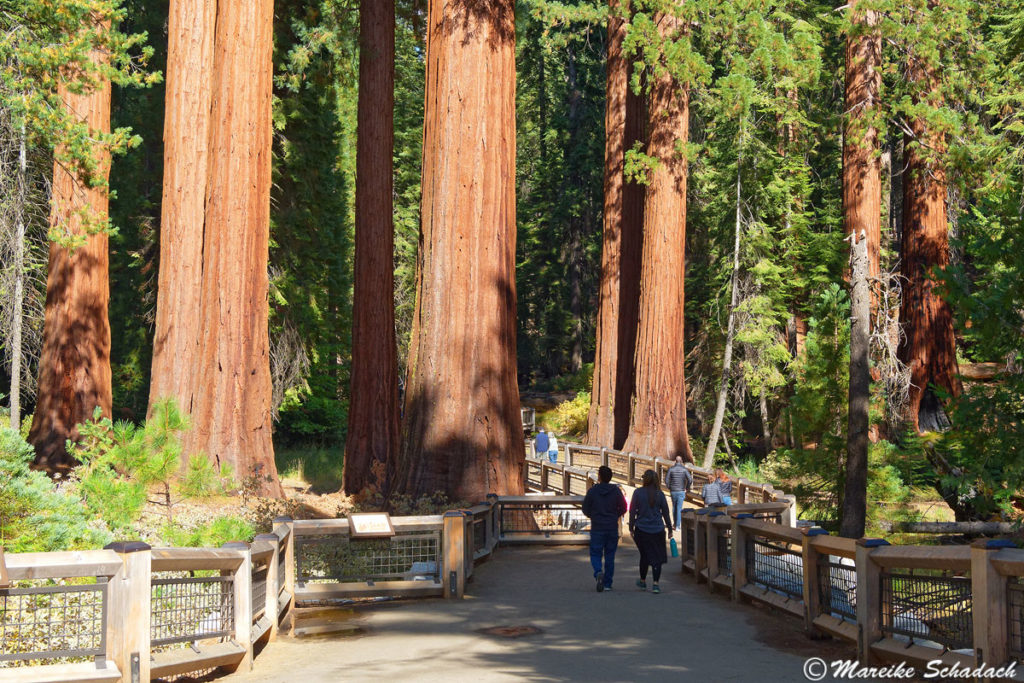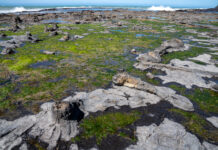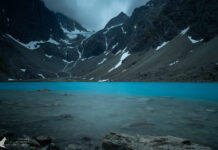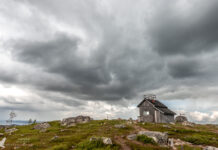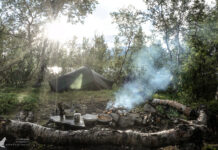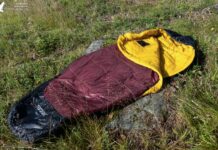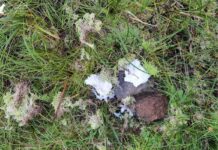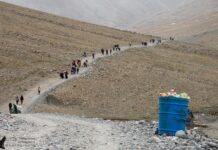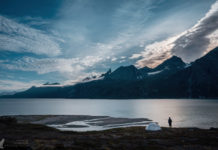The Half Dome is the landmark of Yosemite National Park and one of the most popular photo motifs in the park. The 2,693 meter high, striking mountain top towers over the Yosemite Valley. The ascent of the Half Dome is probably the most famous hike in the National Park. The hike is challenging but absolutely worthwhile. The route leads through beautiful mountain landscapes with impressive waterfalls, rivers and forests up to the treeless summit. In order to reach the top of the Half Dome, cables are stretched over the last 120 metres of altitude. But even with the wire ropes, the last stretch is an exciting adventure and the highlight of the tour. What you have to consider when climbing the Half Dome in Yosemite National Park is explained in my following article. Besides tips for the hike and your packing list, also read information on how to get your permit for the cables.
Unassigned, unpaid advertising. The article contains affiliate links.
Table of Contents and Quick Navigation
The Half Dome in Yosemite National Park
Ascent of the Half Dome
Cables to the Summit of Half Dome
Tips for the Ascent on the Cables
Permit for the Half Dome Cables
The best Season
Weather
Garments
Drinking Water
public toilets
Garbage
Animals
Health and Emergencies
Starting Point, Camp and Parking
Recommendations for the Packing List
The Half Dome in Yosemite National Park
The striking round mountain top of Half Dome was formed by a volcanic eruption with magma outlet below a glacier. It consists of the massive rock granodiorite, which is smooth and largely ungraded.
And what happened to the second half of the Half Dome? Well, there never was one. Seen from the valley it seems that one half of a round dome is missing. But the Half Dome can be seen in its original shape nowadays. During the Ice Age, glaciers sanded the sides of the Half Dome and made them steeper. In addition, rockfalls broke back the northwest wall along a prominent vertical joint and at the top of the Half Dome rock layers peel off like onions.
The Half Dome became widely known through a photograph taken by the American photographer Ansel Adams in 1927. A small gallery with a shop in Yosemite Village shows his most beautiful photographs from the National Park.

Ascent of the Half Dome
The first ascent of the Half Dome took place in 1875 by George Anderson. Today, every year thousands of hikers make their way to the top of the Half Dome. The trail to the icon of the Yosemite National Park is a strenuous hike of about 25 km in length. On the way to the summit, the trail goes almost constantly uphill, sometimes over steep stairs or serpentine-like paths. In total, there are about 1500 metres of altitude to be climbed on the Half Dome. On the last 120 meters of altitude, cables make it possible to climb a gradient of in places over 45° to the summit of the Half Dome.
Depending on how fit you are and how many breaks you take, you will need between 10 and 14 hours to get there and back. It is recommended to start before sunrise. Especially in summer, the temperatures will be more bearable. But even if you start early, it's likely you won't return until after sunset.
The trail to Half Dome is well signposted. There are signs at all junctions. We got along well without map and compass, but we always had a clear view and the trail was well visited. In the dark you have to be careful not to miss any turnoff.
Length of the hike: about 25 km
Height difference: 1500, thereof 120 height meters at the wire ropes
Gradient: up to over 45°
Duration: 10 to 14 hours
But the effort of climbing the Half Dome is worth it. Along the way you have an impressive view of the Vernal Fall and Nevada Fall waterfalls, the Liberty Cap granite dome and the summit of Half Dome. The summit itself offers breathtaking panoramic views of the Yosemite Valley and the High Sierra.
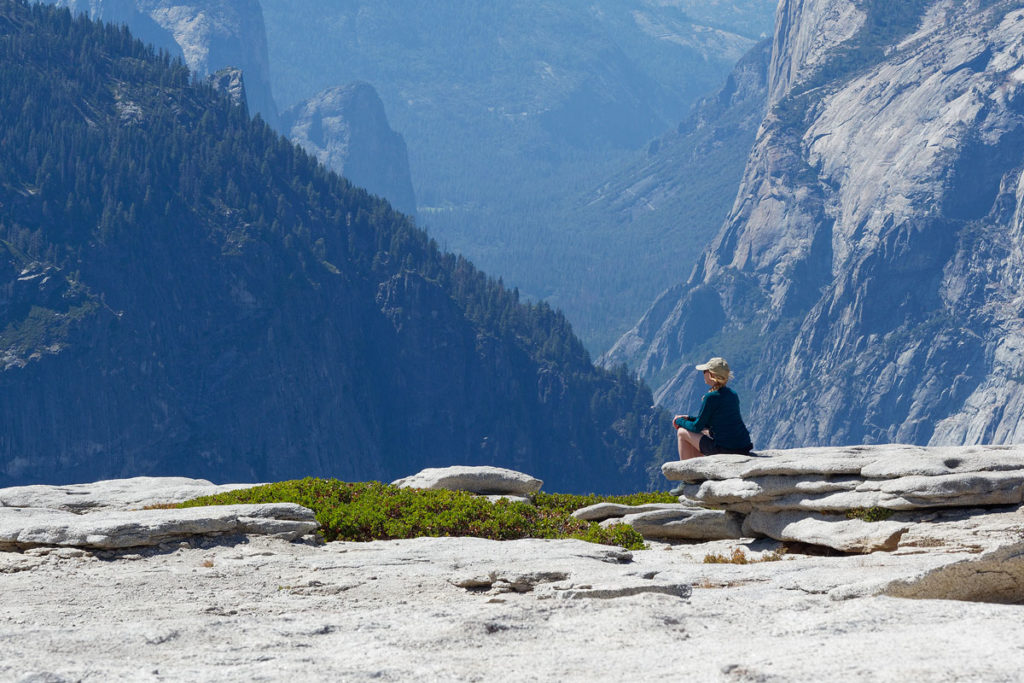
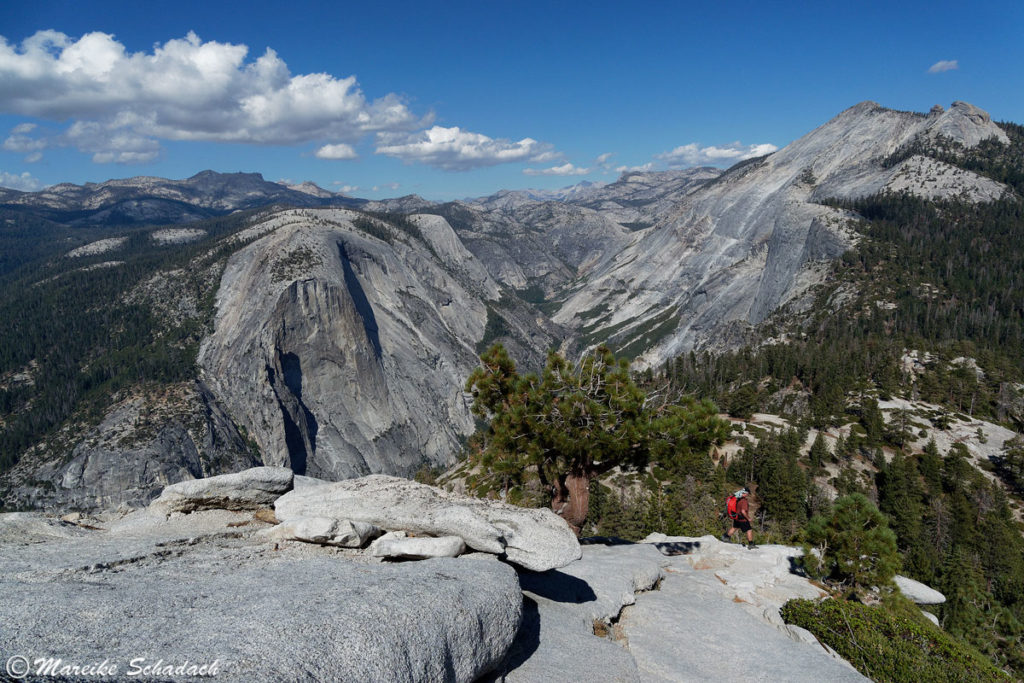
Cables to the Summit of Half Dome
The ascent to the summit of the Half Dome along the wire ropes is the highlight of the hike. As early as 1919, holes were drilled in the rock, into which vertical metal supports were inserted. These supports are then used to guide two wire ropes to the summit at about hip height. In addition to the ropes, wooden planks are laid on the ground above the metal supports. This enables hikers to climb the summit of the Half Dome without special climbing equipment or experience.
Until 2007 there was no known fatal accident on the cables. Since then, however, several people have died. It was not until the summer of 2019 that a young woman crashed. I do not know the background of this accident. If you feel safer and more comfortable climbing, bring a via ferrata set or a rope with a karabiner. Then you can hang up in the most difficult places or if you need a break.
The cables are only attached during the summer months, usually from the end of May to mid-October (between Memorial Day and Columbus Day).
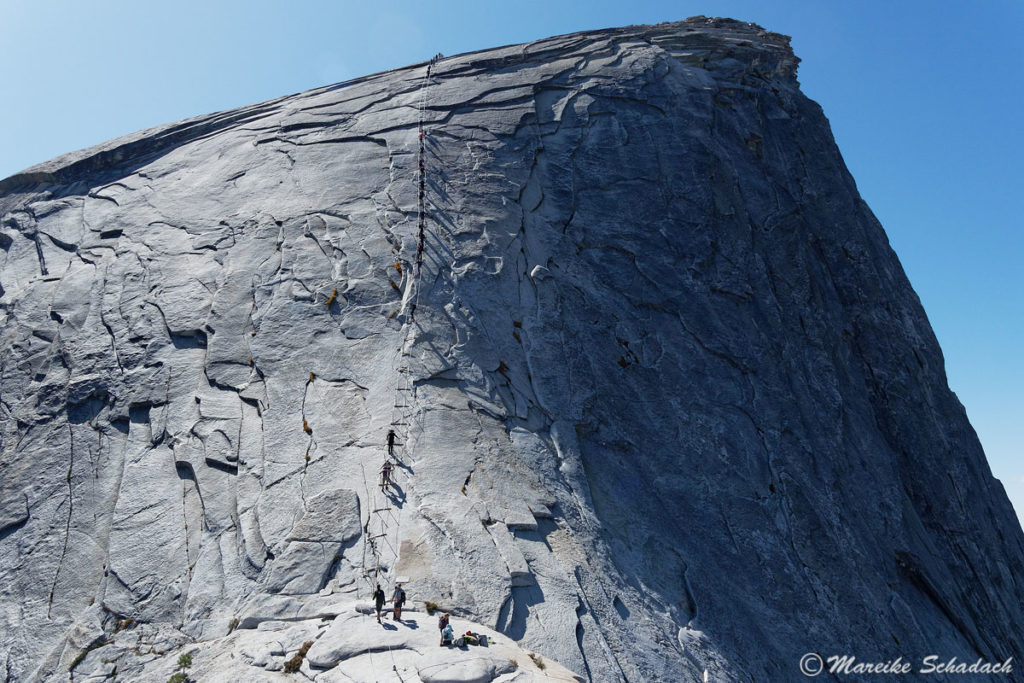
Tips for the Ascent on the Cables
When you've reached the summit on the cables, you've already completed a half-day mountain tour. Time for a long break with a view of the wire ropes. They look extremely steep from below and shy you up a bit when you look at them. But all the hikers who have just made the descent shine all over your face. That motivates you again.
The atmosphere around the cables is characterized by great team spirit. Those who climb up are encouraged. On the other hand, those who have returned to the bottom will be congratulated. On the wire ropes themselves, it is particularly important to communicate with the climbers. Especially with oncoming climbers you have to coordinate how you climb past each other.
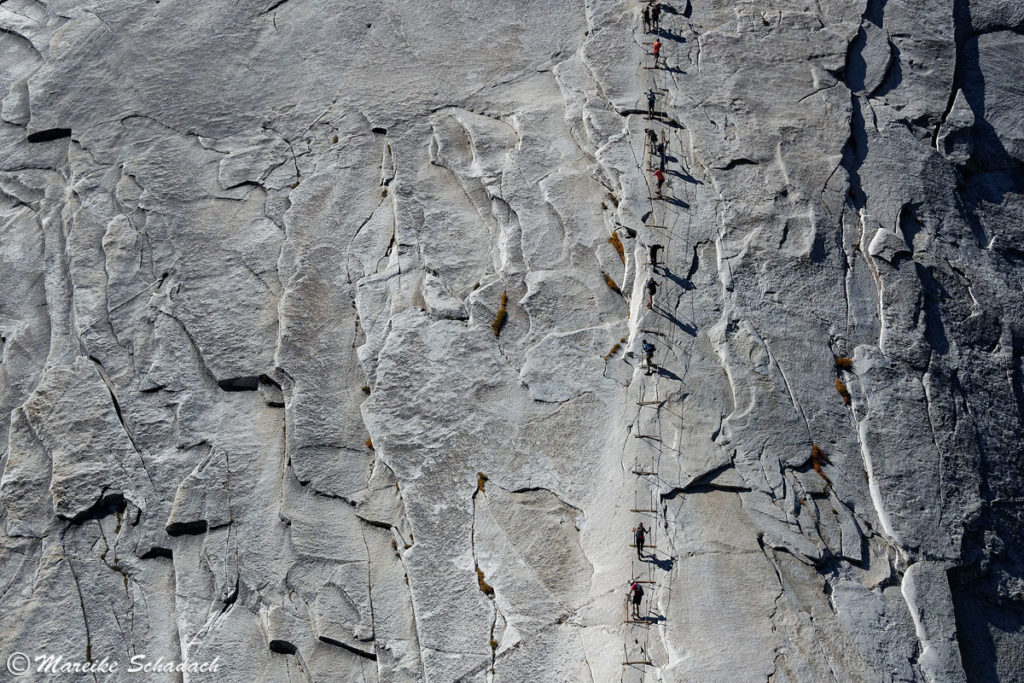

Here are the most important tips:
- Drink again, put camera away, put gloves on
- If you have trekking poles with you, leave them downstairs. You don't need them. And if you attach them to the outside of your backpack, they will only interfere with climbing.
- Always run inside the two wire ropes, with both hands on the ropes.
- If you need a break, it's best to take it where the wooden beams are on the ground. This gives you more support and makes it easier for others to climb past you.
- Take the time you need!
- Be patient with slower climbers!
- Communicate with your fellow climbers, for example whether first you yourself or the one who comes towards you goes.
- Have faster climbers overtake if possible.
- Do not try to climb in the rain. The wire ropes and the granite become slippery when wet.
- If there is still dew on the ground or on the ropes early in the morning, let them dry first.
- Do not climb the summit when storm clouds or thunderstorm clouds are nearby.

Permit for the Half Dome Cables
Since the beginning of 2010, a permit has been required to climb the summit. The number of climbers is therefore limited to a maximum of 300 per day. To obtain a permit, you must first register for the lottery on the National Park Administration website . The lottery takes place in March and 250 permits are drawn for each day of the year. It makes sense to enter several days for the selection. If you walk to several, each of you should try your luck with several days to choose from. If you are lucky several times and get too many tickets, you can return them without any problems.
Another way to get permits is on site. The Wilderness Center in the Yosemite Valley offers individual permits for short stays. It's worth asking.
Important: The person on whose name the permits run has to show their ID card to access the summit. Because here a park ranger stands and controls. So don't forget!

The best Season
Yosemite National Park is a popular destination. Every year about 3.7 million visitors come to the national park. This means that it is full in Yosemite Park. For this reason I would avoid visiting the park during the high season or summer holidays in Caliphonia (mostly July and August). Otherwise you can be prepared for traffic jams, parking shortages and long queues for food or drinks.
The Late spring and early autumnare therefore the best times to get to know the National Park in a more relaxed atmosphere. In spring the waterfalls carry more water. The part of the Half Dome Trail leading up to Vernal and Nevada Falls will be a bit wetter and more slippery than in dry autumn.

Weather
Before you start your hike to Half Dome, be sure to check the weather forecast. When rain, storm or even thunderstorm is announced, be prepared that you probably won't reach the summit. When it rains, the wire ropes and granite of the Half Dome are too slippery. Due to the exposed location at the top of the mountain there is also the danger of lightning during thunderstorms. If thunderclouds or storm clouds form nearby, leave the area of the summit.
The internal reception in the Yosemite Valley is miserable. But you can get the current weather forecast either at the reception of your camp or at the Wilderness Center in Yosemite Village.
The summit of the Half Dome is windy and usually 8°C to 11°C cooler than the Yosemite Valley.
Garments
Dress best in the tried and tested onion layer principle. A warming fleece and an Windbreaker jacket will be appreciated early in the morning, during breaks or on the windy summit. On the other hand, the ascents are sweat-inducing, so here you'll be best served with a quick-drying functional shirt or top. Zip trousers are also a great advantage. I have had good experience with one long and one short sport leggin , which I changed on the way.
The way is very uneven, streaked with roots, stones and therefore peppered with numerous stumbling possibilities. Ankle-high hiking boots are therefore a good protection against twisting. For the possibly wet section at the waterfalls as well as for the last meters of altitude on the summit, the shoes need a good grip sole.
Also important is a pair of sturdy gloves with good grip. Because the wire ropes have to be handcrafted. Here you will have to pull yourself up on the ropes for the most part. The bare metal of the wire ropes quickly becomes slippery in combination with sweat. In addition, without gloves you will quickly get blisters on your hands. If you have forgotten your gloves: ask someone who has just descended if he wants to give you his gloves. It worked for us! Please do not leave the gloves on top of the wire ropes after use.
A basecap is also very pleasant for the treeless stretch. Because here you are exposed to the strong sun in the height without protection.
Drinking Water
Even if it makes the backpack heavy: Take enough drinking water with you. The hike is exhausting and you will sweat out a lot of water. A minimum of 4 litres is recommended. Fortunately, you don't have to start with 4 litres. It is enough to start with 2 litres and refill your bottles on the way.
After about three hours you will reach a good spot on the Merced River near Little Yosemite Valley. Here you can refill your drinking water. This place is easily accessible, so you don't have to climb to the waterfalls. The river also carries water in dry summer. There is also a sign indicating the last possible place to fill.
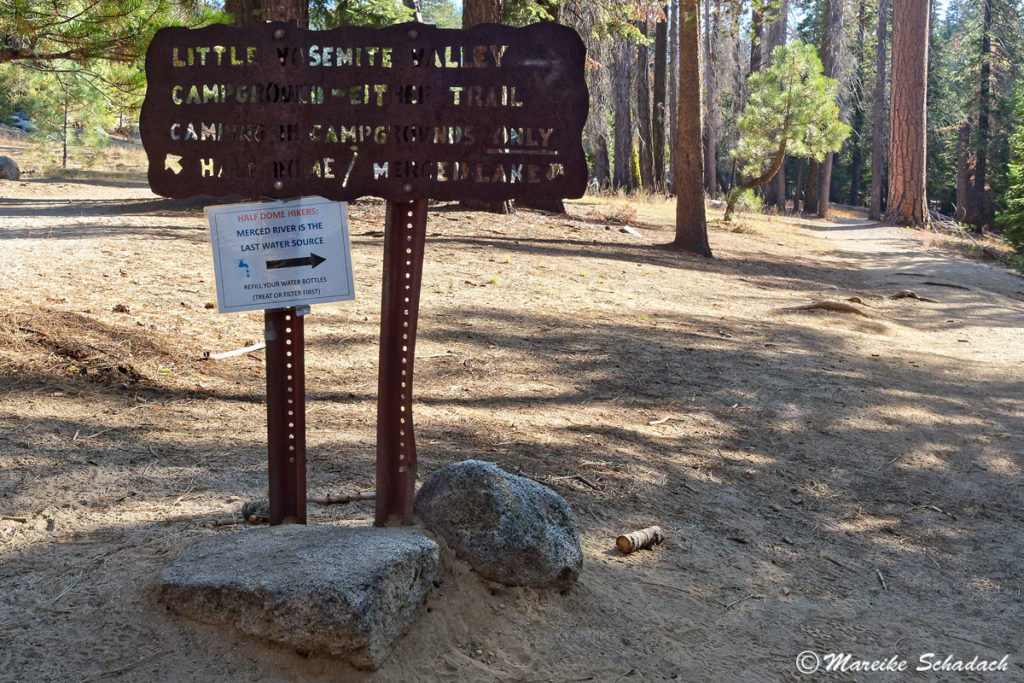
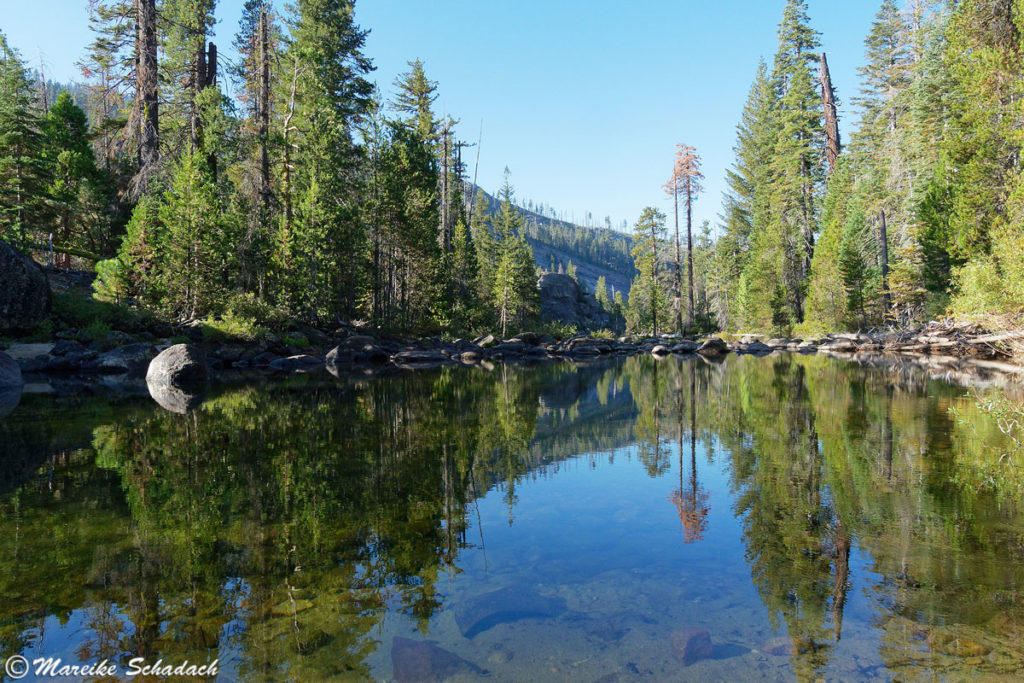
To be on the safe side you should clean the water with disinfectant tablets or a filter or boil it for a few minutes.
But be careful on the stones near the running water and especially above the waterfalls. They can be slippery. There have been many accidents where someone has been washed away by the torrential water of a mountain stream. At the bottom of the Vernal waterfall bridge there is a sign indicating a fatal accident of two boys playing too close to the water.
public toilets
Up to about half of the way there are several toilets along the way:
- Happy Isles
- Vernal Fall Bridge (below Vernal Fall)
- Emerald Pool (above Vernal Fall)
- above the Nevada Fall
- Little Yosemite Valley
If you want to relieve yourself in other places, then you should keep a distance of 30 meters from the water and bury all solids at least 15 cm deep. Also take a garbage bag with you so you can pack the used paper and take it with you.
Garbage
There is no possibility to dispose of garbage on the whole route. So take a bag with you in which you collect your garbage and toilet paper and take it down again. If garbage gets in front of your feet on the way, nature will be happy if you take it down with you.
If you're on the road longer (overnight), you can get bear-safe garbage boxes in the Yosemite Valley.
Animals
During your hike you can observe different animals. The most common is the California squirrel or chipmunk. But even if it's hard: don't feed! Keep wildlife wild!
Auch Black bears can also be found in Yosemite National Park. If you encounter a bear, try to chase it away immediately: make noise, shout and grow up. If there are several of you, get together so that you look even bigger. But make sure you never surround the bear or corner it.
Bears or rodents often search and plunder parked rucksacks for food. So never leave your backpacks unattended, not even at the entrance to the wire ropes. During the day, always keep your backpack or food within reach of your arm or on your back. Also the garbage bag with possibly smelling contents. If you want to stay overnight in the park, get bear-safe food and garbage boxes that you can keep outside the tent.
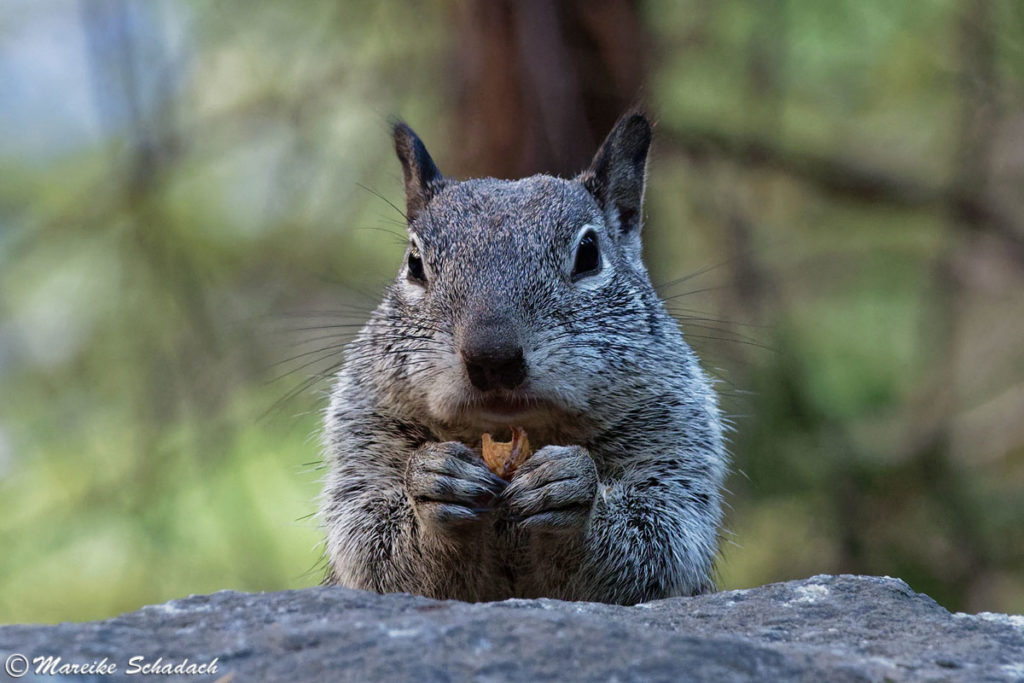

Health and Emergencies
The most common problems experienced by hikers climbing the Half Dome are overheating, dehydration and insufficient electrolyte supply. So make sure you drink and eat enough and take regular breaks in the shade. Some people also react sensitively to altitude, which results in severe headaches and dizziness. It only helps to get down from the mountain and drink a lot.
f you get into difficulties and need help, then you have the following possibilities:
- At some places on the trail there is mobile phone reception. It is worth a try.
- During the summer the Ranger Station in Little Yosemite Valley is occupied. However, it is possible that the ranger is on the way and not there.
- You can also find a ranger at the access control to the summit of the Half Dome.
- Send someone from your hiking group back to Yosemite Valley.
- If you are on your own: the trail is well frequented, so you will always meet hikers you can ask for help.
Starting Point, Camp and Parking
The trail to the Half Dome begins for most hikers at the Happy Isles. The nearest campsites are Upper Pines, Lower Pines and North Pines. The nearest camp with fixed tents is Curry Village. However, you will need reservations for both the campsites and Curry Village. You should make these reservations as early as possible, as especially in summer everything is booked up very quickly.
We decided for a fixed 4-person tent in Curry Village, which we shared with two friends. In the Curry Village there is a cosy lounge available for you during the day and in the evening. There is also a canteen, a cafe, a bar and a pizzeria. From the Curry Village to the Happy Isles it is about 1.2 kilometres.
If you want to drive to the starting point by car, you can use the parking lot just behind Curry Village. From here it is about 0.8 km to the Happy Isles. There is also a bus stop for the shuttle bus, but it doesn't start until 7am.
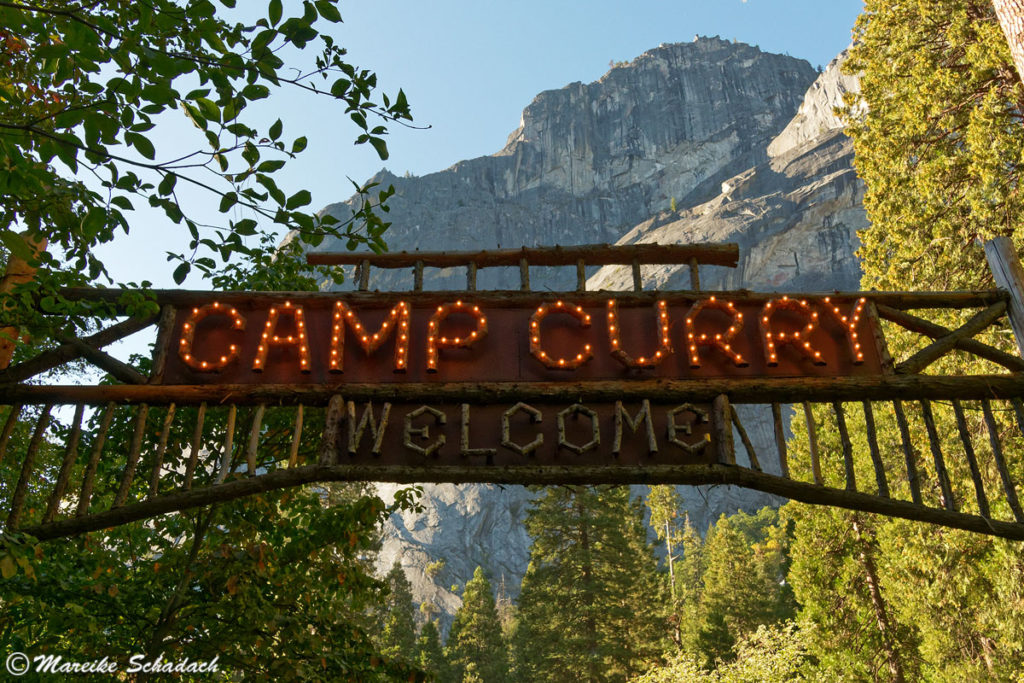

Recommendations for the Packing List for the Ascent of the Half Dome
- Robust, non-slip gloves for the cables
- Rain jacket or windbreaker, because at the top of the summit it is usually windy.
- fleece
- Sun protection and headgear
- Trekking poles, especially for descents
- if necessary a via ferrata set or a rope with a karabiner
- First Aid Pack and Blister Plaster
- Water bottles for at least two litres. The bottles can be refilled half way along a river.
- Water disinfection tablets
- Isotonic beverage powder or tablets
- provisions
- Garbage bags
- Identity card (only the one on whose name the tickets for the Half Dome cables run)
- Hiking boots with non-slip sole
- Headlamp with sufficient charge
- Camera
Geführte Touren und Ausflüge im Yosemite Nationalpark
Book Recommendation for California
You want to know where the journey goes? Then I can recommend these books* about California.
You can order these books at Amazon with a click on the pictures. If you buy a product via one of these affiliate links, I get a small commission and you help me to keep filling Fernweh-Motive with interesting articles. The product will not be more expensive for you.
Have you ever climbed Half Dome yourself? How did you like it? Do you have any questions about my article or suggestions? If so, please write me a comment!
Do you want to know when there are new articles on my blog? Then follow me on Facebook, Pinterest or Instagram. I would also be very happy if you share my article with your friends.




